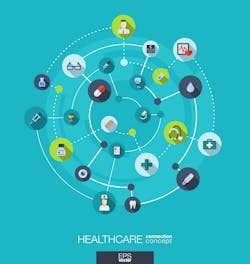In King County, Washington, Navos Mental Health Solutions, a community mental health agency, specializes in serving patients with moderate to severe mental health illnesses and substance use disorders (SUDs). Inclusive of an outpatient mental health clinical, inpatient involuntary psychiatric hospital, intensive community-based support programs, and afterhours triage services, Navos works to provide its patients with whole-person care—including mental, physical, and behavioral healthcare.
However, as is the case for many mental health providers, tracking these patients can be quite difficult, as many of them transition regularly between hospital visits and specialized behavioral care. What’s more, Navos providers were lacking needed insight into key patient histories—including medical records, lab values, medications, and possible SUDs. As such, organizational leaders turned to a care collaboration platform from Utah-based solutions provider Collective Medical to better facilitate transitions of behavioral health patients between hospitals and other facilities.
“One of the big challenges we have without interoperability in healthcare is that you just don’t know when your client goes into the hospital, yet you still have a responsibility to see him or her. So [this platform] really helped us address that issue by [giving] us real-time notifications when our clients were in the ED or hospital,” says Matt Weltner, director of IT at Navos.
Oftentimes, adds Riley Barton, systems analyst at Navos, when the organization’s clients go to the ED, they’re not necessarily getting the best care for their health needs, so it helps Navos target those clients who are utilizing ED services with the goal to get them into Navos’ primary care services, located onsite at its main outpatient center.
With the care collaboration platform, case managers and social workers at Navos could pull regular reports to find and identify their patients at highest risk and work collaboratively with clinical supervisors, medical directors, pharmacists, psych nurses, and members of the King County Public Health department to determine the best plans of care for each patient. These care plans were then housed in the Collective platform.
Another key element is having a nurse care manager who is put in the adult outpatient clinic to bridge medical and mental healthcare. Some of Navos’ clients end up in the ED upwards of 100 times a year, leading to the nurse care manager to focus on these folks specifically, aiming to ensure they have appropriate primary care with the goal to reduce ED visits. While Navos leaders credit the nurse care manager, Stephanie Eller, R.N., for her efforts in this area, they admit that the ED high-utilizers can be the most difficult group to manage.
“We are talking about dementia, drug abuse, severe trauma, and mental health issues. It’s really hard to engage someone in a service when they are homeless, for instance,” notes Jennifer Neumann, licensed independent clinical social worker and clinical systems analyst at Navos. This recognition has led the organization to additionally look at moderate ED users, rather than just the “frequent flyers.”
Barton explains that from reports built in the care management tool, Navos was able to stratify its clients into three different categories determined on how many ED visits they have each year. A deeper look into the data revealed that 50 percent of Navos patients with an ED visit are high-utilizers, 65 percent of ED visits are by high-utilizers, and 18 percent of all active clients are high-utilizers.
At the same time, the idea is to treat someone who visits the ED 85 times a year differently than someone who goes four times a year, Barton says. “We ultimately want to reduce all those ED visits so we can provide the best care through primary care services, but the idea here was to take these different groups of people and stratify how we treat that cohort, because there are fundamentally different issues [for each segment],” he says.
Some of the results touted by Navos leaders help prove that navigating the coordination of care for behavioral health patients can be quite beneficial. For instance, when Navos was notified by the care management tool that a client was at the ED, it became twice as likely that the client would receive appropriate follow-up care within 30 days. Before implementing the tool, Navos would get an alert that one of its clients was in the ED or hospital, but that notification might come days after the admission occurred. What’s more, the organization saw a 15 percent increase in follow-up rates within seven days of hospital discharge, from 37 percent to 52 percent.
Navos executives also contend that they now have the ability to predict which patients will visit the ED in the next 60 days with 92 percent accuracy. A key factor in this predictive work is understanding patients’ patterns of ED utilization as well as which social determinants of health are contributing to the problem.
Indeed, going forward, tracking client ED use over time is an area that Navos leaders are particularly interested in, as they realize that as years of this data piles up, more actionable insights will be gained. If a set of clients had twice the amount of ED visits in 2019 versus 2018, for example, can an assessment be built and given to clinicians to try to identify any commonalities among these individuals? Barton believes that trends will ultimately be uncovered, such as more frequent ED visits will be associated with housing insecurities or not being engaged in peer services.
“We knew we needed to reengage clients and help them adapt their behavior so that they wouldn’t end up back in the ED,” says Neumann. For example, she offers, is a person presenting at the hospital because they see it as a safe place where they can get food? If that’s the case, “let’s engage with the patient to see what else we can do to help address the root of the problem.”


